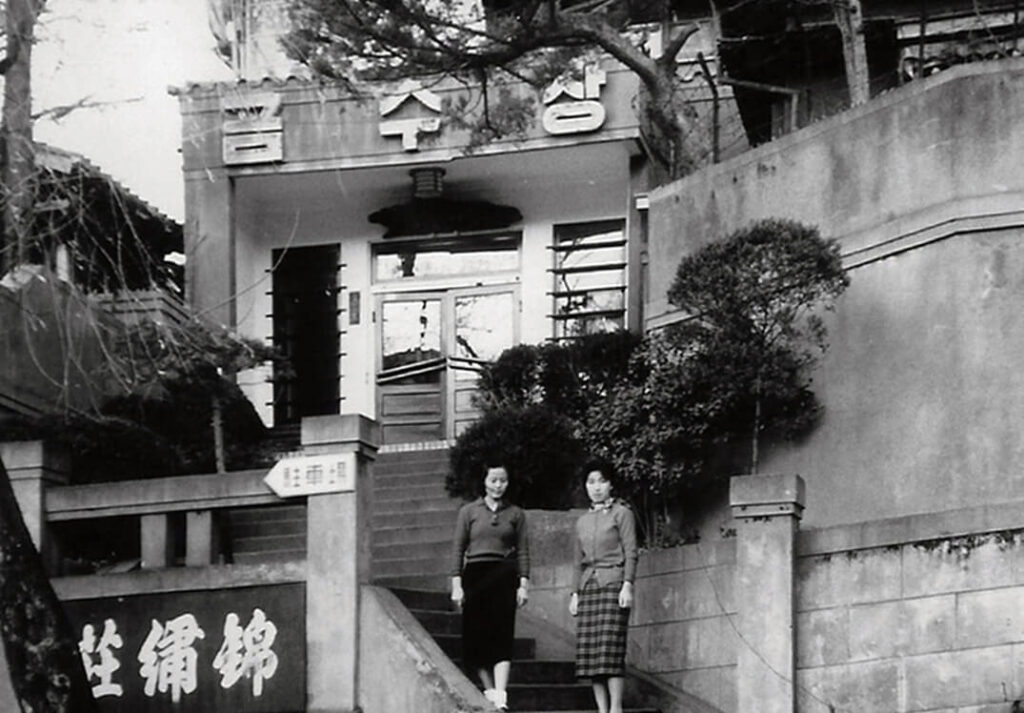History of Korean Lodging
At the beginning of modernization, yeogwan and hotel formed an axis of establishment types. Yeogwan was a modernized form of homegrown establishments such as gaeksa, gaekju and jumak. On the other hand, hotel was a form of western-style establishments, imported through Japan. Lodging establishments in Korea have been diversified since Seoul Olympics in 1988.
- Pre-Modern
- Modern Hotels
- Diversification

Gaeksa means an official residence in each town, composed of a central hall and wings on each side. The wings were used as lodging properties for ambassadors and bureaucrats traveling across the border. Nagan Gaeksa was built on the ruin by the governor In Lee in 1451.

Gaekju means an intermediary merchant mainly brokering trades, as well as offering subsidiary benefits such as lodging and financing. Gaekju refers to a merchant running a lodging establishment, while gaeksa refers to a lodging property operated by the local government. Manduk Kim operated a gaekju business from 1762.

Jumak is a lodging property operated at the private sector like Gaekju and Yeogak, but it also served ordinary travelers as well as merchants. Sauijae is a jumak where Yagyong 'Dasan' Jeong stayed at the beginning of his banishment. He stayed there from 1801 to 1805.

Yeogwan is a lodging property used by international travelers coming to Korean and domestic travelers going out of Korea from Korea-Japan Treaty in 1876. Yeogwans then were mainly converted from existing yeogaks and jumaks. Yusungwan is a late Joseon style yeogwan built in 1914 for visitors and Buddhist monks coming to the temple Daeheungsa.

Yeogwans representing Japanese ryokan style started to be built from Korea -Japan Annexation Treaty in 1910. Yeogwans then had tatami floors and a separate dining space. Boseong Yeogwan was built in the style of a Japanese house and used as a yeogwan, as the region emerged as a transportation hub during the Japanese occupation period.

Japanese Hisataro Hori and his son Rikitaro Hori opened an 11-room Daebul Hotel in 1888 at Jogyeji (now Chinatown) near Incheon Port and operated it for Westerners entering or leaving Seoul. With the opening of the Gyeongin Line in 1899, the need for accommodations in Incheon vanished, and the Daebul Hotel was converted to a Chinese restaurant which was demolished in 1978.

In 1902, Emperor Gojong built a 25-room hotel near Deoksugung Palace, currently the site of the 100th Anniversary Memorial Hall of Ewha Girls' High School, and granted it to a French ritualist Mrs. Antoinette Sontag. The Sontag Hotel began to struggle with financial difficulties after Mrs. Sontag left Korea in 1909, ending up closed down in 1917 with the opening of Chosun Hotel.

The first Chosun Hotel was built with 64 rooms in Sogong-dong, where Hwangudan was located, by the Railway Bureau of the Japanese Government-General of Korea. After liberation, it was used as the US Military Command, and the government of Korea took it over upon establishment of the government. It was used as a temporary residence for Syngman Rhee, the first president, and during the Korean War, it was also used as a US military recreation facility.

It is a 111-room hotel opened in 1938 by Sitagau Noguchi, a Japanese entrepreneur in Korea, right behind the Chosun Hotel. After he was kicked out of the Chosun Hotel due to shabby outfit, he bought a site right behind it and built a hotel twice as tall as the Chosun Hotel. It was transferred to the International Tourism Organization in 1963 with the Chosun Hotel.

In 1955, Seo Hyun-soo, a private entrepreneur, opened a two-story 19-room Geumsujang at the current Ambassador Hotel location. It was renamed as the Ambassador Hotel in 1965, and redeveloped in 1975 to a larger hotel with 450 rooms. It entered into a strategic alliance with the global brand Accor in 1987, which is still in effect. It was the first hotel built by domestic private capital.

In 1961, Kim Jong-pil, the head of the Central Intelligence Agency, promoted the construction of the Walkerhill Hotel as an entertainment facility for the US military, and the project was transferred to the International Tourism Organization. In 1963, the Walkerhill Hotel opened with 26 buildings including five guestroom towers, 13 villas, an observatory and a garage. It was the first hotel in Korea with a night club, a bowling alley and an indoor swimming pool.

In 1964, the Freedom Center of the Asian Anti-communism Federation (now the Korea Freedom Federation) was built in Namsan. At that time, a 17-story free hall was built next to the five-story main building as an accommodation for foreign visitors. It was acquired by the International Tourism Organization in 1966 and renovated to open as the Tower Hotel in 1967. However, it was sold immediately to Gongseong Industry in 1968.

The Korea International Tourism Organization, which took over the Chosun Hotel, finally demolished it to build a new hotel, and pushed for the reconstruction of a large-scale hotel. In 1970, it opened a new 19-story 504-room Chosun Hotel in cooperation with American Airlines of the USA, and affiliated with the global brand Westin in 1981 as Westin Josun Hotel.

In 1973, Lotte acquired Bando Hotel from the International Tourism Organization and also acquired the adjacent site of the National Library. After demolishing the existing buildings, the 38-story Lotte Hotel main building opened in 1979. The duty-free shop was added in 1980 and the new building was added in 1988 when the Olympics were held. It is currently operating as a 1,015-room super hotel.

President Park Chung-hee ordered the construction of a hotel in Namsan, when he attended the completion ceremony of the Namsan Foreign Apartment in 1972. In 1973, the Seoul Miramar Tourism Company was established in a joint venture between Korea and Japan to promote the construction of the Namsan Hotel. Opened in 1978 as a 611-room Hyatt Regency Seoul, the hotel was repositioned to Grand Hyatt Seoul in 1993 after extensive remodeling.

The Park Chung-hee government built the Blue House Guest House in 1967 on the site where a temple dedicated to Hirobumi Ito was located during the Japanese occupation. However, the Blue House handed it over to Samsung in 1973 when privatizing its hotels, and built a new guesthouse within the Blue House. Samsung built the 464-room Shilla Hotel in 1979 next to the guesthouse acquired.

The resort condo was legalized in 1982 through the Tourism Business Act. Each room is equipped with cooking facilities and allowed for member recruiting and unit sales. In the western hemisphere, it is normally known as 'timeshare'. Yongpyong Condo, which opened with 205 rooms in 1984, is an early example.

The family hotel was legalized in 1986 through the Tourism Business Act, as a subcategory of the hotel. It is similar to the resort condo as each room is equipped with cooking facilities and allowed for member recruiting, but different as it is now allowed for unit sales. Muju Deogyusan Resort, which opened in 1990 with 1,392 rooms, is an example.

The traditional hotel was legalized in 1986 through the Tourism Business Act as a subcategory of the hotel, refering to lodging establishments with the style of Korean traditional archtecture. However, it is normally built as a new hanok instead of using an existing one. Seaes Resort & Hotel, which opened in 1991 with 26 rooms, is an example.

The floating hotel was legalized in 1982 through the Tourism Business Act, as a subcategory of the hotel, and transferred to the Tourism Promotion Act in 1999. It uses a ship on the water instead of a building on the land. Ferris Floatel, which opened in 2002 with 53 rooms in Haeundae and closed in 2003, is an example.

The rural minbak is a type of lodging establishments using single-family houses in rural or semi-rural regions. It was legalized in 1995 through the Agricultural and Fishing Villages Improvement Act, and its business registration changed from reporting to designation systems in 2005. Daegwallyeong Beautiful Pension, which opened in 2005 with 6 rooms, is an early example.

The hostel was legalized in 2009 through the Tourism Promotion Act, as a subcategory of the hotel. It is similar to the youth hostel as both of them are affordable lodging options for backpackers, but different as the hostel caters to adults. Hue Hostel, which opened in 2009 with 31 rooms, is an early example.

The urban minbak, which uses houses in urban regions, was legalized at the end of 2011 through the Tourism Promotion Act. It has an advantage to operate in residential areas, but a disadvantage to give proprities to foreign travelers. Studio 41, which opened in 2012 with 7 rooms, is an early example.

The small hotel was legalized in 2014 through the Tourism Promotion Act, as a subcategory of the hotel. It was intended to lower entry barriers for hotels by releasing the requirement for minimum number of rooms, but the advantage of registering as a hotel is not clear. Haslla Museum Hotel, which opened in 2014 with 24 rooms, is an early example.

The Public Health Control Act separated establishments with in-room cooking facilities for extended-stay guests as the residential lodging. However, many of them are struggling with disputes as many of their units were sold as if convertible to houses. The Mark Haeundae, which opened in 2015 with 100 rooms, is an example.

The medical hotel was legalized in 2014 through the Tourism Promotion Act, as a subcategory of the hotel. It was intended to promote medical tourism by providing convenience for foreign medical tourists, while struggling with activation due to complicated requirements for registration. Hotel Vert, which opened in 2023 with 40 rooms, is an example.

